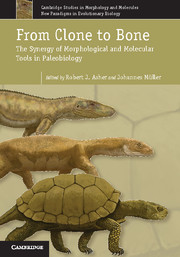Book contents
- Frontmatter
- Contents
- Contributors
- 1 Molecular tools in palaeobiology: divergence and mechanisms
- PART I Divergence
- 2 Genomics and the lost world: palaeontological insights into genome evolution
- 3 Rocking clocks and clocking rocks: a critical look at divergence time estimation in mammals
- 4 Morphological largess: can morphology offer more and be modelled as a stochastic evolutionary process?
- 5 Species selection in the molecular age
- PART II Mechanisms
- 6 Reconstructing the molecular underpinnings of morphological diversification: a case study of the Triassic fish Saurichthys
- 7 A molecular guide to regulation of morphological pattern in the vertebrate dentition and the evolution of dental development
- 8 Molecular biology of the mammalian dentary: insights into how complex skeletal elements can be shaped during development and evolution
- 9 Flexibility and constraint: patterning the axial skeleton in mammals
- 10 Molecular determinants of marsupial limb integration and constraint
- 11 A developmental basis for innovative evolution of the turtle shell
- 12 A molecular–morphological study of a peculiar limb morphology: the development and evolution of the mole's ‘thumb’
- 13 Manus horribilis: the chicken wing skeleton
- Index
- Plate-section
- References
10 - Molecular determinants of marsupial limb integration and constraint
Published online by Cambridge University Press: 05 November 2012
- Frontmatter
- Contents
- Contributors
- 1 Molecular tools in palaeobiology: divergence and mechanisms
- PART I Divergence
- 2 Genomics and the lost world: palaeontological insights into genome evolution
- 3 Rocking clocks and clocking rocks: a critical look at divergence time estimation in mammals
- 4 Morphological largess: can morphology offer more and be modelled as a stochastic evolutionary process?
- 5 Species selection in the molecular age
- PART II Mechanisms
- 6 Reconstructing the molecular underpinnings of morphological diversification: a case study of the Triassic fish Saurichthys
- 7 A molecular guide to regulation of morphological pattern in the vertebrate dentition and the evolution of dental development
- 8 Molecular biology of the mammalian dentary: insights into how complex skeletal elements can be shaped during development and evolution
- 9 Flexibility and constraint: patterning the axial skeleton in mammals
- 10 Molecular determinants of marsupial limb integration and constraint
- 11 A developmental basis for innovative evolution of the turtle shell
- 12 A molecular–morphological study of a peculiar limb morphology: the development and evolution of the mole's ‘thumb’
- 13 Manus horribilis: the chicken wing skeleton
- Index
- Plate-section
- References
Summary
Introduction
What are the intrinsic factors responsible for shaping mammalian biodiversity? This question is highly relevant to discussion of the two groups of therian mammals alive today, marsupials (kangaroos, possums, etc.) and placentals (humans, bats, whales, etc.). Despite arising at the same time, marsupials have never achieved the taxonomic or morphologic diversity of their sister group, the placentals (Lillegraven 1975; Kirsch 1977; Sears 2004; Cooper and Steppan 2010). To explain this phenomenon, scientists hypothesized that the evolution of marsupials had been constrained relative to that of placentals as a result of marsupials’ unique mode of reproduction (Lillegraven 1975; Klima 1987; Sanchez-Villagra and Maier 2003).
Subsequent research confirmed that marsupials are less morphologically diverse and specialized than placentals (Sears 2004; Cooper and Steppan 2010; Kelly and Sears 2011a). Sears (2004) found that the shoulder girdles of living and extinct adult marsupials are less diverse than those of adult placentals, and adult marsupial scapulae are less morphologically diverse than adult marsupial pelves, as predicted by the marsupial constraint. Cooper and Steppan (2010) and Kelly and Sears (2011a) found that this pattern extended to forelimb versus hind limb comparisons in living mammals. Sears (2004) also linked this reduction in morphological diversity to a reduction in morphologic variation during development as a result of the functional requirements on the marsupial newborn.
- Type
- Chapter
- Information
- From Clone to BoneThe Synergy of Morphological and Molecular Tools in Palaeobiology, pp. 257 - 278Publisher: Cambridge University PressPrint publication year: 2012
References
- 6
- Cited by



